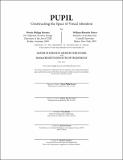PUPIL : constructing the space of visual attention
Author(s)
Kassner, Moritz Philipp; Patera, William Rhoades
DownloadFull printable version (29.13Mb)
Alternative title
Constructing the space of visual attention
Other Contributors
Massachusetts Institute of Technology. Dept. of Architecture.
Advisor
Terry Knight and Patrick Winston.
Terms of use
Metadata
Show full item recordAbstract
This thesis explores the nature of a human experience in space through a primary inquiry into vision. This inquiry begins by questioning the existing methods and instruments employed to capture and represent a human experience of space. While existing qualitative and quantitative methods and instruments -- from "subjective" interviews to "objective" photographic documentation -- may lead to insight in the study of a human experience in space, we argue that they are inherently limited with respect to physiological realities. As one moves about the world, one believes to see the world as continuous and fully resolved. However, this is not how human vision is currently understood to function on a physiological level. If we want to understand how humans visually construct a space, then we must examine patterns of visual attention on a physiological level. In order to inquire into patterns of visual attention in three dimensional space, we need to develop new instruments and new methods of representation. The instruments we require, directly address the physiological realities of vision, and the methods of representation seek to situate the human subject within a space of their own construction. In order to achieve this goal we have developed PUPIL, a custom set of hardware and software instruments, that capture the subject's eye movements. Using PUPIL, we have conducted a series of trials from proof of concept -- demonstrating the capabilities of our instruments -- to critical inquiry of the relationship between a human subject and a space. We have developed software to visualize this unique spatial experience, and have posed open questions based on the initial findings of our trials. This thesis aims to contribute to spatial design disciplines, by providing a new way to capture and represent a human experience of space.
Description
Thesis (S.M.)--Massachusetts Institute of Technology, Dept. of Architecture, 2012. This electronic version was submitted by the student author. The certified thesis is available in the Institute Archives and Special Collections. Page 180 blank. Cataloged from student-submitted PDF version of thesis. Includes bibliographical references (p. 168-171).
Date issued
2012Department
Massachusetts Institute of Technology. Department of ArchitecturePublisher
Massachusetts Institute of Technology
Keywords
Architecture.